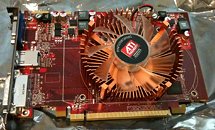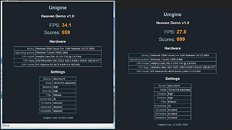- Joined
- Oct 9, 2007
- Messages
- 47,612 (7.45/day)
- Location
- Dublin, Ireland
| System Name | RBMK-1000 |
|---|---|
| Processor | AMD Ryzen 7 5700G |
| Motherboard | Gigabyte B550 AORUS Elite V2 |
| Cooling | DeepCool Gammax L240 V2 |
| Memory | 2x 16GB DDR4-3200 |
| Video Card(s) | Galax RTX 4070 Ti EX |
| Storage | Samsung 990 1TB |
| Display(s) | BenQ 1440p 60 Hz 27-inch |
| Case | Corsair Carbide 100R |
| Audio Device(s) | ASUS SupremeFX S1220A |
| Power Supply | Cooler Master MWE Gold 650W |
| Mouse | ASUS ROG Strix Impact |
| Keyboard | Gamdias Hermes E2 |
| Software | Windows 11 Pro |
AMD's lower-mainstream DirectX 11 compliant graphics card slated for Q1-2010, the ATI Radeon HD 5670 has been pictured and detailed, sourced from a [H]ardOCP HardForum community member. The HD 5600 series is based on a 40 nm GPU codenamed "Redwood". From the specifications the GPU-Z screenshot shows, it has a 50% downscaled SIMD engine, with 400 stream processors, while it retains the 128-bit wide GDDR5 memory interface, with 16 ROPs. Assuming the clock speeds shown in the screenshot to be the reference speeds, they are 775 MHz for the core, and 1000 MHz for the 1 GB of memory (resulting in 64 GB/s of memory bandwidth).
An engineering-sample of the card has also been pictured, revealing a red-colored PCB breaking away from the black PCB scheme of the rest of the HD 5000 series. The card draws all its power from the PCI-Express slot. The GPU cooler consists of a simple heatsink with radially-projecting metal fins, in which is nested a fan. Output connectivity includes DVI, HDMI, and D-Sub, though the leads behind the D-Sub connector shows that offering a DisplayPort in its place might be possible.


The user also put the card through two tests, in a performance comparison with the Radeon HD 4670 512 MB, the card this one replaces. The test-bed comprised of a Intel Core i5 750 @ 2.66 GHz, Gigabyte P55M-UD2, and 4 GB of OCZ DDR3-1333 memory. The first test was Street Fighter 4 1600 x 1200, no AA, 16x AF. The HD 5670 scored 10,473 points, with average frame-rate of 95.35 fps. The HD 4670 on the other hand, scored 8,559 points with average frame-rate of 65.35 fps. Next was Unigine Heaven Demo v1.0 DirectX 10 (SM 4.0) 1024 x 768, windowed. With the CPU running at 2.53 GHz (according to the screenshot), the HD 5670 scored 859 points with 34.1 fps frame-rate, while the HD 4670 with the CPU running at 2.66 GHz scored 699 points with 27.8 fps.

View at TechPowerUp Main Site
An engineering-sample of the card has also been pictured, revealing a red-colored PCB breaking away from the black PCB scheme of the rest of the HD 5000 series. The card draws all its power from the PCI-Express slot. The GPU cooler consists of a simple heatsink with radially-projecting metal fins, in which is nested a fan. Output connectivity includes DVI, HDMI, and D-Sub, though the leads behind the D-Sub connector shows that offering a DisplayPort in its place might be possible.


The user also put the card through two tests, in a performance comparison with the Radeon HD 4670 512 MB, the card this one replaces. The test-bed comprised of a Intel Core i5 750 @ 2.66 GHz, Gigabyte P55M-UD2, and 4 GB of OCZ DDR3-1333 memory. The first test was Street Fighter 4 1600 x 1200, no AA, 16x AF. The HD 5670 scored 10,473 points, with average frame-rate of 95.35 fps. The HD 4670 on the other hand, scored 8,559 points with average frame-rate of 65.35 fps. Next was Unigine Heaven Demo v1.0 DirectX 10 (SM 4.0) 1024 x 768, windowed. With the CPU running at 2.53 GHz (according to the screenshot), the HD 5670 scored 859 points with 34.1 fps frame-rate, while the HD 4670 with the CPU running at 2.66 GHz scored 699 points with 27.8 fps.

View at TechPowerUp Main Site












